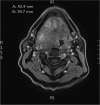Oropharyngeal rhabdomyoma: the cause of severe sleep apnoea?
- PMID: 32041754
- PMCID: PMC7021167
- DOI: 10.1136/bcr-2019-230949
Oropharyngeal rhabdomyoma: the cause of severe sleep apnoea?
Abstract
This case report presents an elderly male patient who on diagnosis with a large oropharyngeal tumour had no specific symptomatology apart from severe obstructive sleep apnoea. Histopathology revealed the tumour to be an adult rhabdomyoma, a rare but benign tumour arising from striated muscle cells. The tumour obstructed most of the oropharyngeal space and almost occluded the patient's airway when lying in a supine position. The patient was deemed operable, and the tumour was excised in toto using a transoral robotic surgery system. On follow-up, the patient had a severe reduction of apnoeas/hypopnoeas and felt subjectively 'reborn'. This is to our knowledge the first case where an adult rhabdomyoma is removed using a robot-assisted approach, thus presenting a new and viable option when considering removal of benign tumours of the pharynx leading to a very minor degree of morbidity for the patients.
Keywords: ear, nose and throat; head and neck surgery; otolaryngology / ENT; sleep disorders (respiratory medicine).
© BMJ Publishing Group Limited 2020. No commercial re-use. See rights and permissions. Published by BMJ.
Conflict of interest statement
Competing interests: None declared.
Figures




Similar articles
-
Adult rhabdomyoma in the parapharyngeal space: report of 2 cases and review of the literature.Am J Otolaryngol. 2011 May-Jun;32(3):240-6. doi: 10.1016/j.amjoto.2010.01.007. Epub 2010 Apr 13. Am J Otolaryngol. 2011. PMID: 20392534 Review.
-
Rhabdomyoma of the parapharyngeal space presenting with dysphagia.Dysphagia. 2008 Jun;23(2):202-4. doi: 10.1007/s00455-007-9125-0. Epub 2007 Oct 27. Dysphagia. 2008. PMID: 17965913
-
An unusual cause of obstructive sleep apnoea.J Laryngol Otol. 2009 Nov;123(11):e22. doi: 10.1017/S0022215109990910. Epub 2009 Aug 19. J Laryngol Otol. 2009. PMID: 19689845
-
[The monthly interesting case - case no. 56. Adult rhabdomyoma].Laryngorhinootologie. 2003 Apr;82(4):286-8. doi: 10.1055/s-2003-38940. Laryngorhinootologie. 2003. PMID: 12717605 German. No abstract available.
-
Extensive rhabdomyoma of the head and neck region: a case report and a literature review.Minerva Stomatol. 2013 Oct;62(10):387-95. Minerva Stomatol. 2013. PMID: 24217686 Review. English, Italian.
Cited by
-
Histologically confirmed pediatric extracardiac rhabdomyoma: case series.Discov Oncol. 2025 Jan 7;16(1):17. doi: 10.1007/s12672-025-01741-x. Discov Oncol. 2025. PMID: 39775349 Free PMC article.
References
-
- Semelka M, Wilson J, Floyd R. Diagnosis and treatment of obstructive sleep apnea in adults. Am Fam Physician 2016;94:355–60. - PubMed
Publication types
MeSH terms
LinkOut - more resources
Full Text Sources
Research Materials
Miscellaneous
